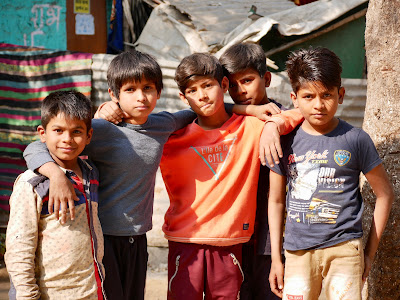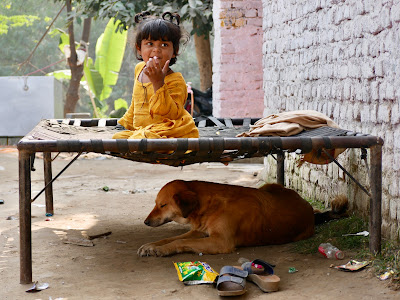"We have about three million posters, but we don't really know what we've got"
I stood in Poster Stuff, a tiny shop in Mumbai's Chor Bazar, trying to decide which of two vintage Bollywood posters to buy, Baazi or Albela While I struggled to make my choice, Kaleem, whose grandfather started the business 22 years ago explained that only a tiny proportion of the collection is held in the store. The remainder of it is kept outside the city in Badlapur. I asked him if the shop has a website or a catalogue. "No, he said "We have about three million posters, but we don't really know what we've got". Putting off my decision a little longer, I asked him how his grandfather had managed to acquire so large a collection. He said "He would get to know when a cinema was closing and then ask if they would give him their old posters. Most of them did not appreciate their value and were happy to hand them over. Sometimes he was too late and found that they had already been destroyed".
Kaleem is extremely knowledgeable about old films, although he said he prefers modern cinema. I ran through my list of 1940's, 1950's and early 1960's movies, and he was able to either locate a poster for me or to tell me that it had been sold or sent for auction. "A lot of our business is with overseas dealers" he explained. "We've even sold some at the big art auction houses in London. We also get approached by dealers and collectors to verify that posters are originals and not copies. The National Museum of Indian Cinema in Mumbai recently asked for our advice".
Chor Bazar is undergoing major change. Many of the old shops have been demolished and replaced by new structures with residential units above. Some businesses will not reopen when the re-development is complete. I asked Kaleem about the future of the store. He said "If this part of Mutton Street is demolished, we have been promised a new store on the same spot". I hope that promise is kept.
"It's the work of Sheikh Rehman, the last of the hand-painted poster artists"
I made my mind up and chose the poster for Baazi, a Hindi film released in 1951. It was the first crime noir film to be made in India and is acknowledged as a classic of the genre and influenced many films in later years. It was directed by Guru Dutt, who also starred in, wrote, produced and choreographed many classic Hindi films from this period. Baazi, which means "gamble" starred Dev Anand, Geeta Bali of Albela fame, and Kalpna Kartik. It was the second highest grossing Indian film of 1951. At least two other Hindi films, made in 1968 and 1995 bear the same name but tell different stories.
While I arranged to have the poster delivered to my hotel, Kaleem said "actually this is not a poster, but a painting. It's the work of Sheikh Rehman, the last of the hand-painted poster artists", and pointed to the artist's signature. I had heard of Rehman before, but enamoured with the deep reds, blues and downward brush strokes of his work, I hadn't picked up on his name.
Sheikh Abdul Rehman - better known as S. Rehman - began helping his poster painting father at the age of ten and has continued with this work for more than 50 years. His painting led him to establish friendships with Mother India director Mehboob Khan and Bollywood superstar actor Shashi Kapoor. He also worked with artist MF Husain, one of the founders of the Bombay Progressive Artists Group who was later forced to leave India following controversy over his depictions of female Hindu deities. A 2015 documentary film, Original Copy, showed Rehman at work in his studio right behind the screen at the Alfred Talkies cinema. The German made film showed various aspects of his personality - a bit prickly, fond of robust language but with a good sense of humour.
Alfred Talkies was open for business but there was no warm welcome
Kaleem confirmed that Alfred Talkies still existed and was not too far from Chor Bazar, so with my friend and guide, Ranjana, I made my way to the cinema in Grant Road. This area was once an entertainment hub with many single screen cinemas attracting large audiences for the latest Hindi films. Today few remain and those that do, tend to show re-runs of old movies rather than the latest hits. This part of the city also has a long history of prostitution. As we walked along the road in the early afternoon, many women were on the street looking for customers. SM Edwards, noted in his 1924 book Crime In India, that the Ripon Theatre, the precursor of the Alfred, charged a special rate to prostitute patrons - one rupee. This was four times the amount charged to other women. The writer Saadat Hasan Manto lived in this neighbourhood before Partition, writing screenplays and working as a columnist for various film magazines. No doubt several of his characters were inspired by the people he met in these streets.
The cinema stands at the end of Grant Road East, and before we reached it, we passed New Roshan Talkies, another single screen cinema. It is now closed, and at least externally, in poor shape. Despite this, it was easy to imagine its former splendour as the brightly coloured detailing and Art Deco influenced metalwork of the ticket windows has survived.
Alfred Talkies was open for business, but there was no warm welcome. Just inside the lobby, three grim faced men, arms folded, sat on wooden chairs and told us we couldn't come in, take any pictures or make any films. This was backed up by a series of "don't..." notices displayed on the walls of the once very grand lobby. Stained glass, wooden panelling and several less off-putting vintage notices have survived, but unfortunately I have no photographic record of them. Ranjana explained we were interested in the story of the cinema and would like to have a peep inside the main hall. Despite her best efforts she received a firm "no". She tried again with the ticket sellers, one of whom eventually gave in and allowed us to look into the hall from the doorway, but once again warned us against photography and filming. Inside, the all male audience were watching the 1989 film Ram Lakhan. Tickets are priced at just 20 rupees, about 20p. Unfortunately this was reflected in the poor print and the appalling sound quality. All of the house lights were on, and the restless audience called repeatedly for them to be turned off, which they eventually were. We asked about seeing the balcony but were told it was closed because there were not enough customers.
We were soon bustled outside again and crossed the road to get a better view of the exterior. The cinema was built in 1880, originally as the Ripon Theatre, and the old name can still be seen, engraved on the windows at the upper level. It was one of the first theatres in the city to put on plays in local languages. In the 1930's, in line with changing tastes, it was modified to become a cinema and the name was changed to Alfred Talkies. It is now one of very few single screen cinemas in the city. Many of the older buildings on the opposite side of the road have been flattened and replaced with large, often ugly, "developments" that seem to threaten, rather than to attract. How long will it be before the art works from the Alfred become part of Poster Stuff's collection?
Alfred Talkies - 174-180, Pathe Bapurao Marg, Grant Road East, Khetwadi, Girgaon, Mumbai.
Poster Stuff - 113 Mutton Street, below Qutbi Masjid, Ajmer, Kumbharwada, Mumbai








